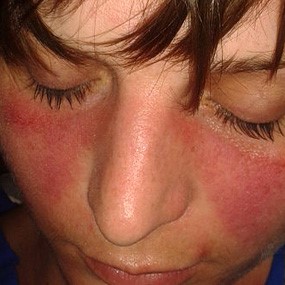Protecting yourself from the harmful rays of sunlight is always important, but especially so for those with lupus symptoms. Find out how exposure to the sun can trigger lupus symptoms and get tips on protecting your sensitive skin.
Many lupus patients are photosensitive or have extreme sensitivity to ultraviolet (UV) rays. Sunlight is the main source of this harmful light for lupus patients, but flourescent light can also trigger lupus symptoms. Typical symptoms include rashes on the face and body, including the malar rash (butterfly rash) which appears on the bridge of the nose and cheeks and discoid rashes that appear as raised scaly lesions on areas that have received direct sunlight exposure. These symptoms appear in about 50-75% of all lupus patients.
Ultraviolet (UV) Rays in Sunlight and Lupus
Ultraviolet light consists of three different bands of light: UVA, UVB and UVC. According to Amita Bishnoi, MD, a rheumatologist at Henry Ford Hospital in Detroit, "Patients with lupus are most sensitive to UVA and UVB light."
UV light is invisible to the naked eye. It is the radiation in sunlight. Lupus is similar to cancer in the way that it comes and goes in periods of high activity and low activity in what some call "remission." Direct exposure to UV rays, particularly sunlight, can cause lupus symptoms to arise after a long period of dormancy or inactivity. These active periods where lupus symptoms become worse are called lupus flares.
Sunlight and the Immune System
One of the main functions of the body's immune system is to get rid of dying, dead or defective cells. The process for this is called apoptosis. It is believed that the UV rays from sun exposure causes your skin to burn and die (sun burn). These dead cells stimulate the immune system into activity. However, in lupus patients, the response by the immune system is slower and the dead cells linger for a longer period of time. These cells produce an inflammatory response by the immune system, causing swelling and the common lupus rash. A sun burn that causes massive cell death can result in lupus symptoms on large areas of the skin and even affect the muscles, joints and internal organs.
Protection from Sunlight
Dr. Bishnoi advises that, "It is best to avoid prolonged sun exposure. Make sure you use sunscreen with SPF (sun protection factor) greater than or equal to 15, and one that blocks both UVA and UVB rays. Wear protective clothing. Use a broad-brimmed hat, long-sleeved shirt, and long pants if you are going to be outside for long periods of time. Also, watch out for photosensitive medications, which can make you even more sensitive to sunlight."
Here are some more tips to protecting yourself from harmful UV rays in sunlight and avoiding lupus symptoms:
- Avoid prolonged sun exposure, especially during the hottest parts of the day. Water, clouds and other natural substances do not sufficiently protect you from UV rays of the sun.
- Apply more sunscreen than you think you need. To receive the maximum SPF indicated on the sunscreen, you need to apply at least one ounce of sunscreen per application.
- Avoid other sources of UV light. Sun exposure is not the only source of UV rays. Fluorescent lights and photocopiers emit UV radiation as well. Also, tanning beds are extremely dangerous for lupus patients.
- Some medication can cause you to become even more sensitive to sunlight. Talk with your pharmacist and doctor before starting any new medication.
- Not all windows will protect you from UV rays. Many home windows only protect from UVB but not UVA. Check with the window manufacturer to see if you are protected from both.
Because lupus patients are extremely sensitive to sunlight, it is important you take the necessary precautions to avoid prolonged sun exposure and protect yourself from the harmful ultraviolet (UV) rays of direct sunlight.